
The Poetic Edda is the modern name for an untitled collection of Old Norse anonymous narrative poems in alliterative verse. It is distinct from the closely related Prose Edda, although both works are seminal to the study of Old Norse poetry. Several versions of the Poetic Edda exist: especially notable is the medieval Icelandic manuscript Codex Regius, which contains 31 poems.
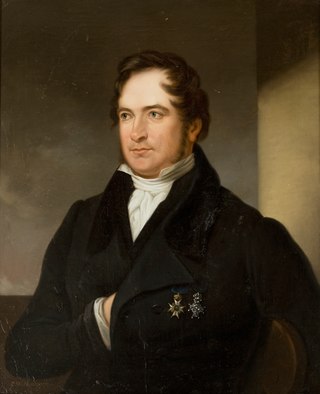
Erik Gustaf Geijer was a Swedish writer, historian, poet, romantic critic of political economy, philosopher, and composer. His writings served to promote Swedish National Romanticism. He was an influential advocate of conservatism, but switched to liberalism later in life.
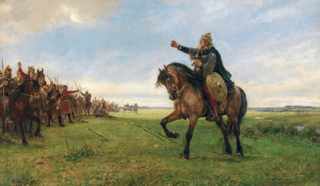
Hlöðskviða, known in English as The Battle of the Goths and Huns and occasionally known by its German name Hunnenschlachtlied, is an Old Norse heroic poem found in Hervarar saga ok Heiðreks. Many attempts have been made to try to fit it with known history, but it is an epic poem, telescoping and fictionalising history to a large extent; some verifiable historical information from the time are place names, surviving in Old Norse forms from the period 750–850, but it was probably collected later in Västergötland.
Dan (or Halfdan) is the name of one or more legendary earliest kings of the Danes and Denmark, mentioned in medieval Scandinavian texts.

Håkan the Red was a King of Sweden, reigning for about half a decade in the second half of the 11th century. There is little information on him, and it is mostly contradictory. Nothing is known about his reign.
Olaus Magnus was a Swedish writer, cartographer, and Catholic clergyman.

Johannes Magnus was the last functioning Catholic Archbishop in Sweden, and also a theologian, genealogist, and historian.
Gaut is an early Germanic name, from a Proto-Germanic gautaz, which represents a mythical ancestor or national god in the origin myth of the Geats.
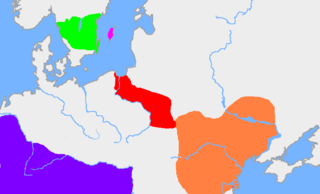
Berig is a legendary king of the Goths appearing in the Getica by Jordanes. According to Jordanes, Berig led his people on three ships from Scandza (Scandinavia) to Gothiscandza. They settled and then attacked the Rugians who lived on the shore and drove them away from their homes, subsequently winning a battle against the Vandals.
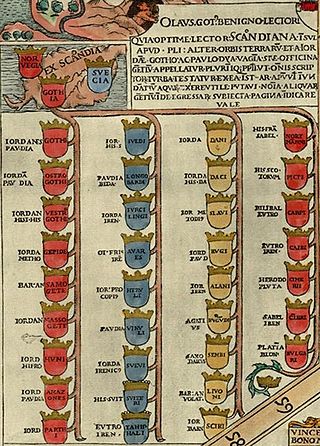
Gothicism or Gothism was a dacianistic cultural movement in Sweden, which took honor in being a Swede, who were related to the illustrious Goths as the Goths originated from Götaland. The founders of the movement were Nicolaus Ragvaldi and the brothers Johannes and Olaus Magnus. The belief continued to hold power in the 17th century, when Sweden was a great power following the Thirty Years' War, but lost most of its sway in the 18th. It was renewed by the Viking revival and Romantic nationalism in the early 19th century, this time with the Vikings as heroic figures.

Scanian law is the oldest Danish provincial law and one of the first Nordic provincial laws to be written down. It was used in the geographic region of Danish Skåneland, which at the time included Scania, Halland, Blekinge and the island of Bornholm. It was also used for a short period on the island of Zealand. According to some scholars, the Scanian Law was first set down between 1202 and 1216, around the same time it was translated into Latin by the Danish Archbishop Anders Sunesøn.
The title of King of the Goths was for many centuries borne by both the kings of Sweden and the kings of Denmark.

Magnus Vasa, prince of Sweden, Duke of Östergötland from 1555. Magnus was the third son of King Gustav Vasa. His mother was queen Margareta Leijonhufvud.

Johan Hadorph was a Swedish director-general of the Central Board of National Antiquities.

"Töres döttrar i Wänge" or "Per Tyrssons döttrar i Vänge" is a medieval Swedish ballad which Ingmar Bergman's The Virgin Spring is partly based on. The ballad type is found throughout Scandinavia, with variants in Danish, Faroese, Icelandic, and Norwegian. The Child Ballad "Babylon" is analogous to the Scandinavian songs.
Harpens kraft (Danish) or Harpans kraft, meaning "The Power of the Harp", is the title of a supernatural ballad type, attested in Danish, Swedish, Norwegian, and Icelandic variants.
Roland og Magnus kongen literally "Roland and King Magnus," also known under the English title "Roland at the Battle of Roncevaux" is a Norwegian ballad about the legendary hero Roland of Charlemagne's court. The ballad is cataloged NMB 171, and categorized TSB type E 29. In the ballad, Roland's sword is compared to a sickle, its name corrupted to Dvælje=Dvolg, explained as meaning "dwarf-fiend" or "enemy of the dwarfs" Storm was of the opinion that the ballad could not be younger than the end of the 15th century, and Halvorsen also said it "must have been handed down orally since the late Middle Ages".
"Elveskud" or "Elverskud" is the Danish, and most widely used, name for one of the most popular ballads in Scandinavia.
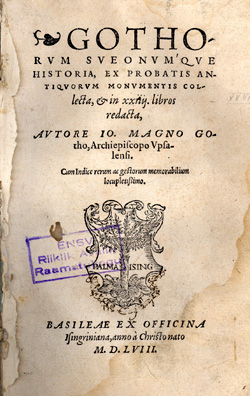
The Historia de omnibus Gothorum Sueonumque regibus is a posthumously published, partly pseudo-historical work by Johannes Magnus, Sweden's last Catholic archbishop. In 1554 it was published in Latin by his brother Olaus Magnus.
The Hjalmars och Ramers saga is a forgery of a saga produced in Sweden at the end of the seventeenth century. It tells the story of King Hjalmar and his close friend Ramer as they engage in various conflicts set in ancient Scandinavia.